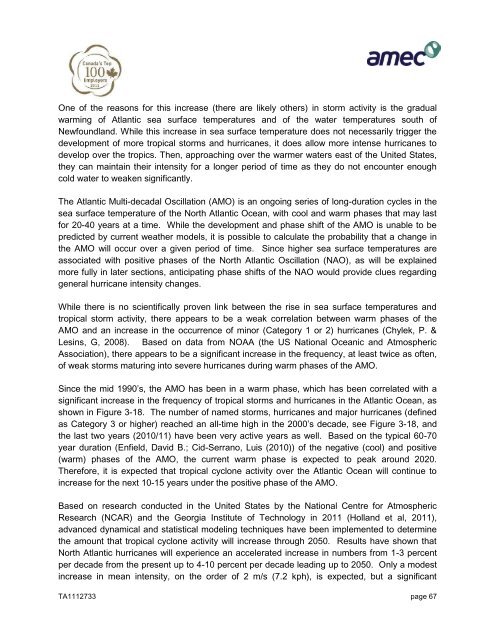Flood Risk and Vulnerability Analysis Project - Atlantic Climate ...
Flood Risk and Vulnerability Analysis Project - Atlantic Climate ...
Flood Risk and Vulnerability Analysis Project - Atlantic Climate ...
Create successful ePaper yourself
Turn your PDF publications into a flip-book with our unique Google optimized e-Paper software.
One of the reasons for this increase (there are likely others) in storm activity is the gradual<br />
warming of <strong>Atlantic</strong> sea surface temperatures <strong>and</strong> of the water temperatures south of<br />
Newfoundl<strong>and</strong>. While this increase in sea surface temperature does not necessarily trigger the<br />
development of more tropical storms <strong>and</strong> hurricanes, it does allow more intense hurricanes to<br />
develop over the tropics. Then, approaching over the warmer waters east of the United States,<br />
they can maintain their intensity for a longer period of time as they do not encounter enough<br />
cold water to weaken significantly.<br />
The <strong>Atlantic</strong> Multi-decadal Oscillation (AMO) is an ongoing series of long-duration cycles in the<br />
sea surface temperature of the North <strong>Atlantic</strong> Ocean, with cool <strong>and</strong> warm phases that may last<br />
for 20-40 years at a time. While the development <strong>and</strong> phase shift of the AMO is unable to be<br />
predicted by current weather models, it is possible to calculate the probability that a change in<br />
the AMO will occur over a given period of time. Since higher sea surface temperatures are<br />
associated with positive phases of the North <strong>Atlantic</strong> Oscillation (NAO), as will be explained<br />
more fully in later sections, anticipating phase shifts of the NAO would provide clues regarding<br />
general hurricane intensity changes.<br />
While there is no scientifically proven link between the rise in sea surface temperatures <strong>and</strong><br />
tropical storm activity, there appears to be a weak correlation between warm phases of the<br />
AMO <strong>and</strong> an increase in the occurrence of minor (Category 1 or 2) hurricanes (Chylek, P. &<br />
Lesins, G, 2008). Based on data from NOAA (the US National Oceanic <strong>and</strong> Atmospheric<br />
Association), there appears to be a significant increase in the frequency, at least twice as often,<br />
of weak storms maturing into severe hurricanes during warm phases of the AMO.<br />
Since the mid 1990‟s, the AMO has been in a warm phase, which has been correlated with a<br />
significant increase in the frequency of tropical storms <strong>and</strong> hurricanes in the <strong>Atlantic</strong> Ocean, as<br />
shown in Figure 3-18. The number of named storms, hurricanes <strong>and</strong> major hurricanes (defined<br />
as Category 3 or higher) reached an all-time high in the 2000‟s decade, see Figure 3-18, <strong>and</strong><br />
the last two years (2010/11) have been very active years as well. Based on the typical 60-70<br />
year duration (Enfield, David B.; Cid-Serrano, Luis (2010)) of the negative (cool) <strong>and</strong> positive<br />
(warm) phases of the AMO, the current warm phase is expected to peak around 2020.<br />
Therefore, it is expected that tropical cyclone activity over the <strong>Atlantic</strong> Ocean will continue to<br />
increase for the next 10-15 years under the positive phase of the AMO.<br />
Based on research conducted in the United States by the National Centre for Atmospheric<br />
Research (NCAR) <strong>and</strong> the Georgia Institute of Technology in 2011 (Holl<strong>and</strong> et al, 2011),<br />
advanced dynamical <strong>and</strong> statistical modeling techniques have been implemented to determine<br />
the amount that tropical cyclone activity will increase through 2050. Results have shown that<br />
North <strong>Atlantic</strong> hurricanes will experience an accelerated increase in numbers from 1-3 percent<br />
per decade from the present up to 4-10 percent per decade leading up to 2050. Only a modest<br />
increase in mean intensity, on the order of 2 m/s (7.2 kph), is expected, but a significant<br />
TA1112733 page 67














